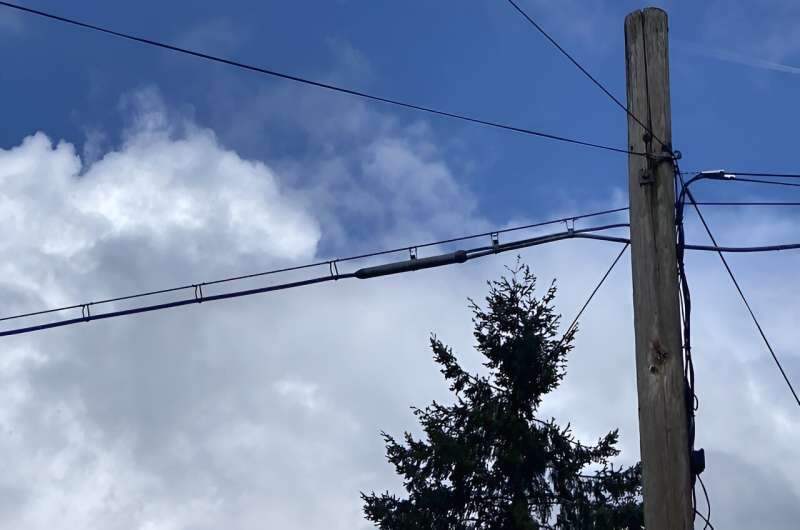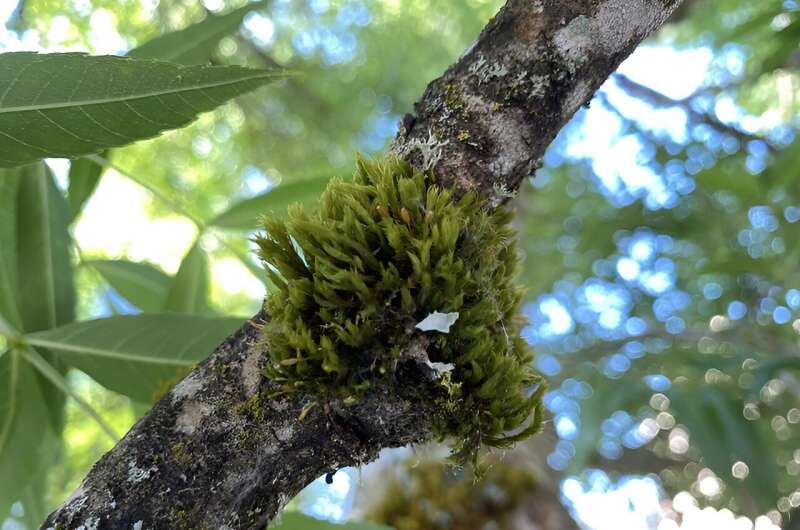This article has been reviewed according to Science X's editorial process and policies. Editors have highlighted the following attributes while ensuring the content's credibility:
fact-checked
peer-reviewed publication
trusted source
proofread
Study of urban moss raises concerns about lead levels in older Portland neighborhoods

Lead levels in moss are as much as 600 times higher in older Portland, Oregon, neighborhoods where lead-sheathed telecommunications cables were once used compared to lead levels in nearby rural areas, a new study of urban moss has found.
The findings raise concerns about lead exposure in pre-1960 neighborhoods where the cables were common and in some cases are still in place even though they are no longer in use, said Alyssa Shiel, an environmental geochemist at Oregon State University, and the study's lead author.
Lead is a highly toxic metal. Children are particularly vulnerable to lead exposure, which can lead to developmental delays, difficulty learning and behavioral issues.
"The results were pretty surprising. The vast majority of the samples with high lead levels were in areas with these old telecom cables," said Shiel, an associate professor in OSU's College of Earth, Ocean, and Atmospheric Sciences.
"Based on these findings, we've already started research to understand if and how the lead is getting into the environment. By doing that, we can learn if people are being exposed to the lead, and if so, by how much."
The study was just published in Communications Earth & Environment. Co-authors are Sarah Jovan of the U.S. Forest Service and Christina Murphy of Oregon State.
Shiel began studying lead in urban moss in Portland several years ago, following research by Jovan that identified high levels of cadmium in Portland ultimately traced to local glass manufacturing businesses that used cadmium-based pigments to make colored glass.
Moss growing on trees in urban areas is an effective air monitoring system because it has a wide surface area to collect contaminants that settle out of the air around it.
"These mosses are letting us know what is being picked up in the air we breathe," said Shiel, who is also a member of the Pacific Northwest Center for Translational Environmental Health Research at OSU.
The researchers' goal for the new study was to better understand urban lead levels and learn more about their potential sources. Samples of Orthotrichum lyelli, a type of moss typically found growing on trees, were collected from across Portland in 2013, and in nearby rural areas in 2017.
The findings showed nearly 12 times higher lead levels in urban Portland than found in rural areas nearby. Chemical analysis indicates that much of the lead in the environment is due to leaded gasoline, which continues to persist in the environment nearly three decades after it was banned in the United States.
"The lead introduced into the environment by leaded gas just hasn't gone away. We have to live with it," Shiel said.

But some older neighborhoods showed much higher concentrations of lead, which left the researchers puzzled and looking for more answers. An investigation published in 2023 by the Wall Street Journal connecting lead in older cities to telecommunications cables spurred a new line of inquiry for Shiel and her colleagues.
In summer 2023, the researchers collected additional moss samples, this time focusing on older neighborhoods where lead-sheathed telecommunication cables are still in place or had been removed in the recent past.
"We wanted to see if the impact of lead cables was consistent across neighborhoods where the cables were present," Shiel said.
They found that neighborhoods with lead cables had more than two times the lead levels of those without lead cables, and more than 38 times higher than the samples from rural areas. The highest concentrations of lead were found in samples collected within one meter of a lead cable.
The researchers hypothesize that lead from the cables is being leached by rain slowly over time, accumulating in the soil and vegetation including moss below. Contaminated soil can also become airborne, transporting lead to areas not directly under the cables.
"We do see that the lead is migrating," Shiel said. "The moss samples are showing that lead is not just dormant in soil near the telecom cables but is being mobilized in the air."
More research is needed to understand how far lead from the cables may be spreading, Shiel noted, and the researchers plan to conduct soil testing in these areas next to determine how much lead is in the soil.
There is enough evidence of high levels to raise concerns about potential health impacts, she said.
"We were not expecting this result. But whether or not these higher levels of lead result in people being exposed depends in part on what people are doing in those places," Shiel noted. "Right now, we are recommending people avoid interacting with or disturbing soil in those areas where these cables are or were present in the recent past."
Shiel has developed a website with a map that shows the age of different neighborhoods across the city, as well as pictures of old telecom cables, so residents can determine if their neighborhood has these cables or may have had them in the past. The site includes additional information about the potential lead contamination and how to reduce the risk of exposure.
Shiel emphasized that other sources of lead should not be overlooked. The most common source of lead poisoning in the U.S. is household dust and soil containing lead from lead-based paints, she noted.
The federal Centers for Disease Control and Prevention recommend all children who are at risk for lead exposure be tested for lead poisoning.
"I would encourage parents to discuss lead testing with their child's health provider," Shiel said. "Seeking a test would be a reasonable course of action for concerned families."
More information: Lead-sheathed telecom cables and historic leaded gasoline emissions 5 substantially raise environmental lead levels in Portland, Oregon, Communications Earth & Environment (2024). DOI: 10.1038/s43247-024-01534-0
Journal information: Communications Earth & Environment
Provided by Oregon State University




















